G
Guest
Guest
I gotta admit, I love the soloized Penobscot as a big boy, big load tripper. Everything except the Royalex weight, but I am done carrying canoes very far.
The outfitting on the Penobscot was a multi year work in progress, and I have everything dang near exactly how I want it for comfort, convenience and safety. The jet boat driver on the Green called it The Inspector Gadget canoe, which I took as high praise, and they never even saw it with spray covers on.
The Cooke Custom Sewing partial spray covers suit my needs superbly, and the paddle pockets and straps are beyond useful for holding paddles, sail and pole accessible
Single blade, double blade, and sail on bow cover.
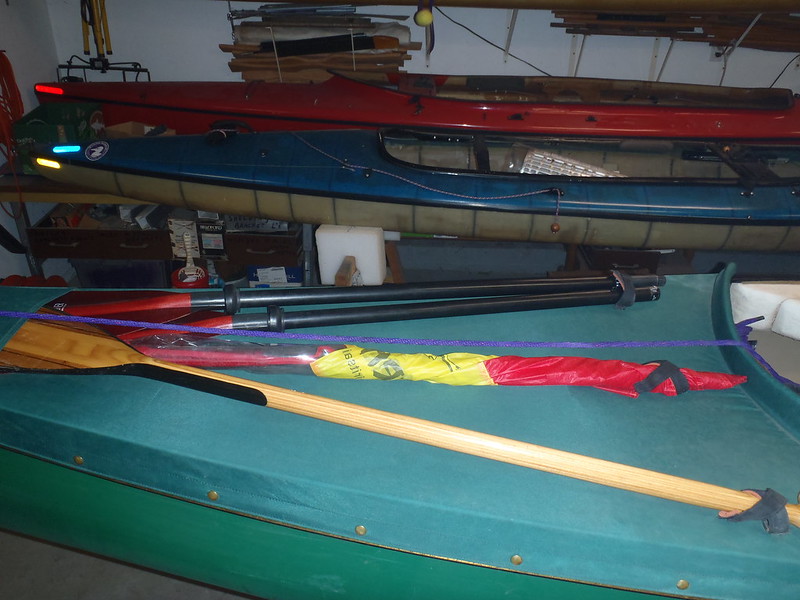 P2160520 by Mike McCrea, on Flickr
P2160520 by Mike McCrea, on Flickr
6 foot push pole, hiking staff, spare tarp pole on stern cover.
 P2160519 by Mike McCrea, on Flickr
P2160519 by Mike McCrea, on Flickr
With the spray covers attached there is no carry thwart available to grab at the stems, so grab handles on the painter loops are handy for when I really need to haul on something more hand kindly than rope.
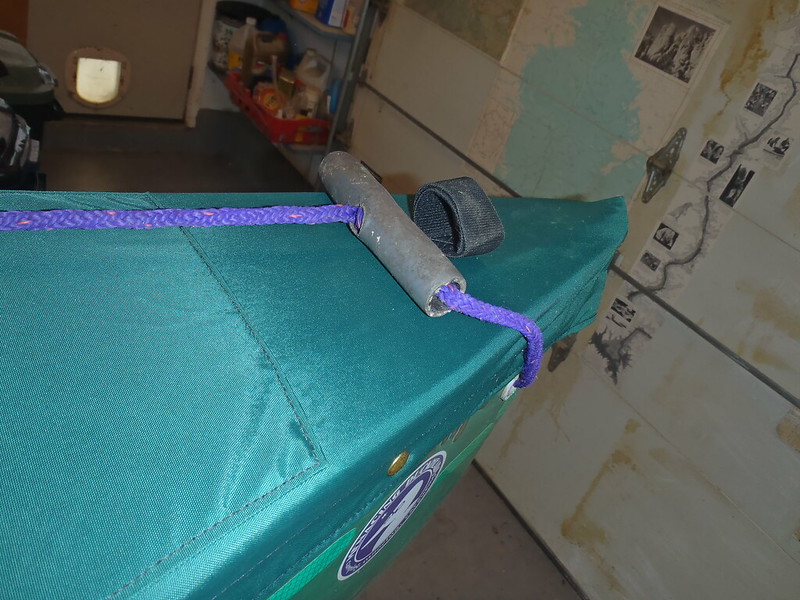 P2160522 by Mike McCrea, on Flickr
P2160522 by Mike McCrea, on Flickr
The painter lines do not usually go in that Velcro loop on the fabric. With the covers on there is not a lot of exposed gunwale to grab for control when exiting the canoe in wind or wave, and having the painters secured 8 feet away does not help.
Open cleat on the utility thwart for the bow line, along with the sail mount and compass. Dang, I really need to disassemble the utility thwart and drops and refinish them.
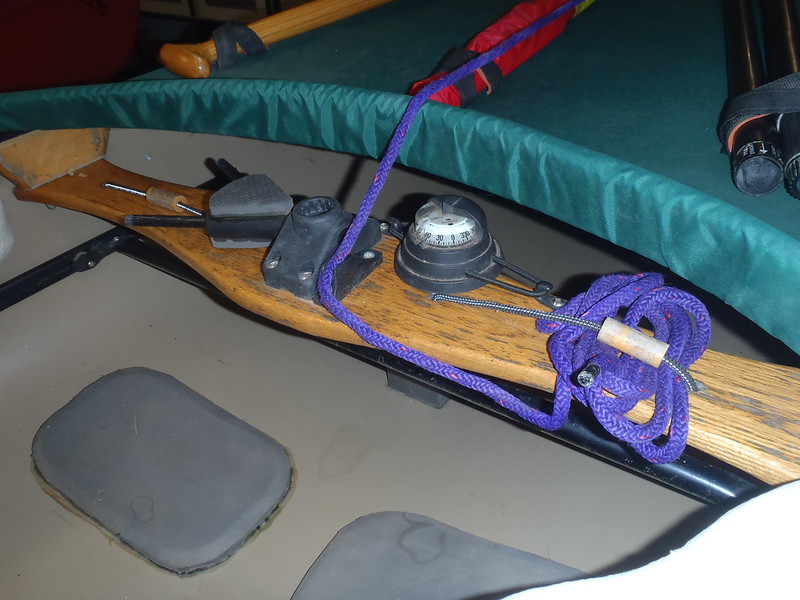 P2160525 by Mike McCrea, on Flickr
P2160525 by Mike McCrea, on Flickr
Open cleat on truss seat drop for stern painter, in case I need to grab the stern line as well.
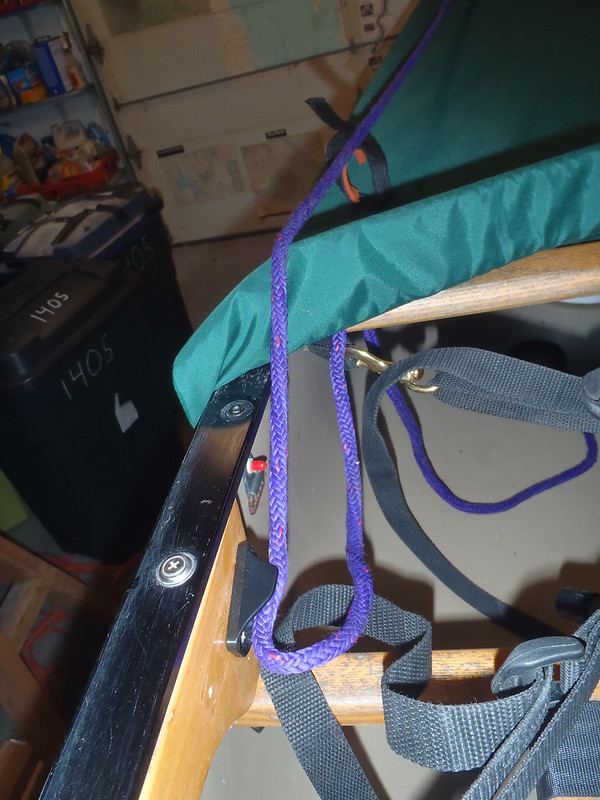 P2160526 by Mike McCrea, on Flickr
P2160526 by Mike McCrea, on Flickr
Sail away.
 P2160528 by Mike McCrea, on Flickr
P2160528 by Mike McCrea, on Flickr
Barcalounger comfortable with a slightly canted contour seat, inflation adjustable pad and back band. Another reason beefy truss drops are handy.
 P2160535 by Mike McCrea, on Flickr
P2160535 by Mike McCrea, on Flickr
Foot brace and heel pads.
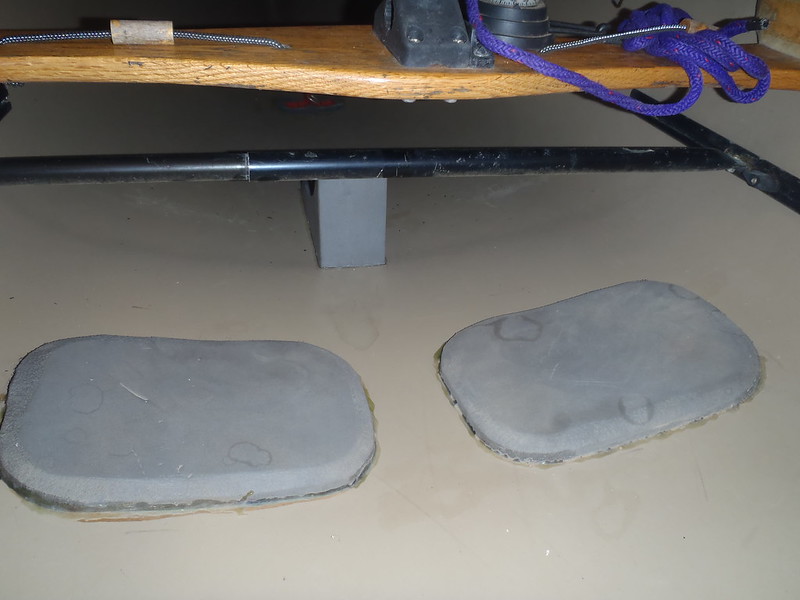 P2160530 by Mike McCrea, on Flickr
P2160530 by Mike McCrea, on Flickr
Four strategically placed D rings along the keel line. Webbing loop tie down points on the machine screw ends. Minicel wedge that holds the 30 or 60 liter barrel trapped between thwarts and away from the adjustable foot brace. That little minicel wedge is terrific to seat a barrel and hold it solidly from any movement.
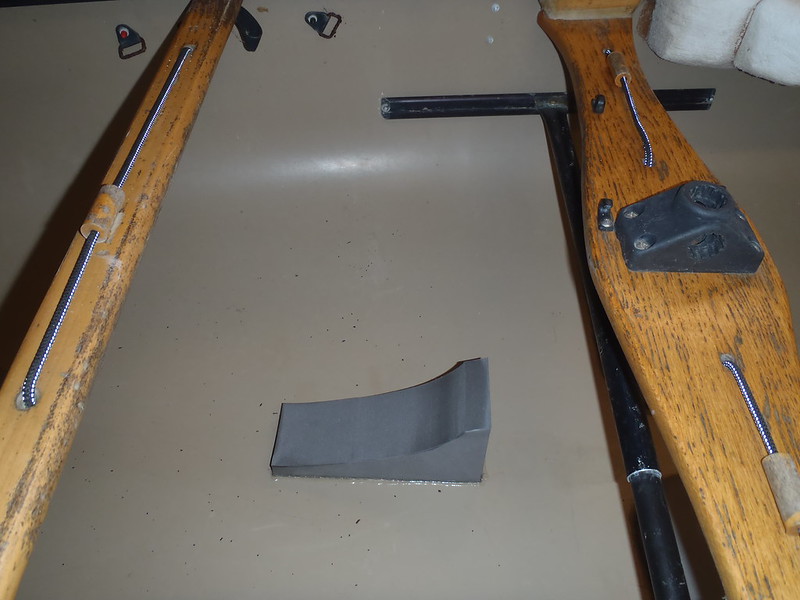 P2170546 by Mike McCrea, on Flickr
P2170546 by Mike McCrea, on Flickr
Strap yoke with stainless double D rings
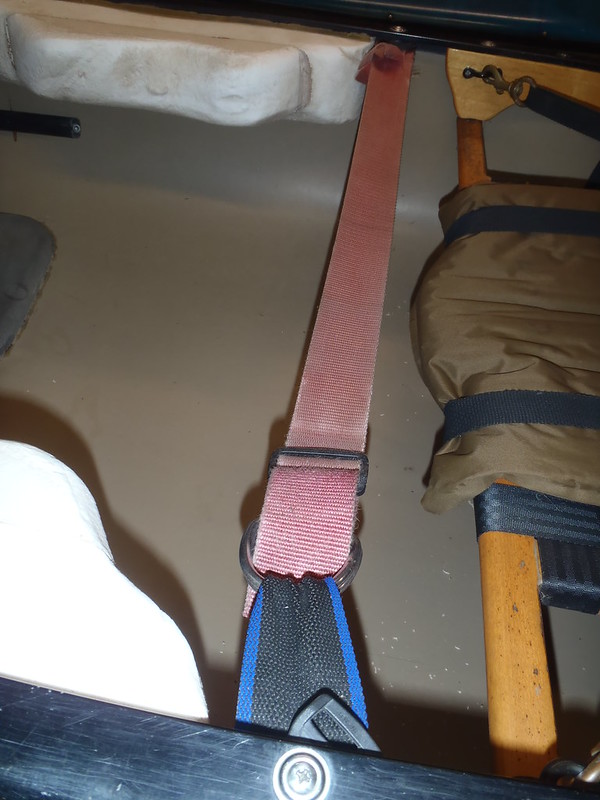 P2160534 by Mike McCrea, on Flickr
P2160534 by Mike McCrea, on Flickr
Massive knee bumpers. Those took multiple trips to get custom carved just right, but I can trim shift my bulk fore or aft a bit on the seat and still comfortably brace my knees, or thigh brace off the bottoms when I really want to lock in.
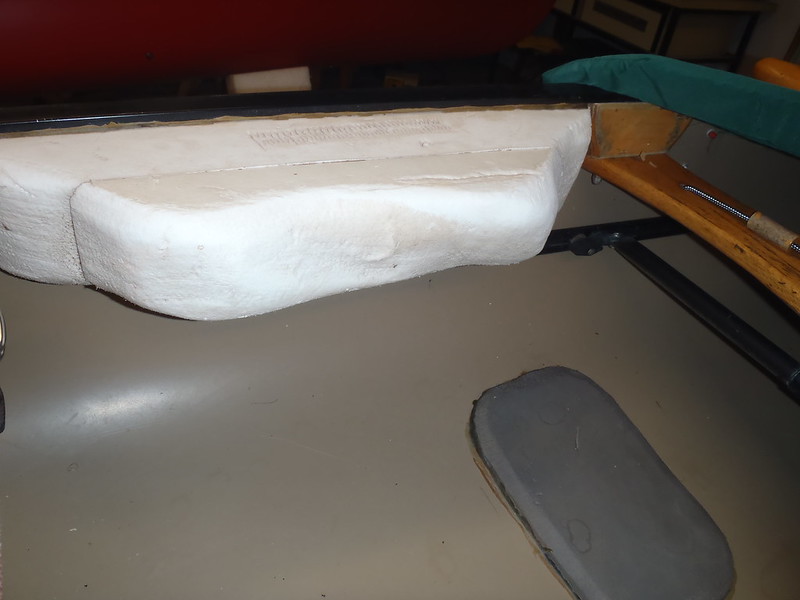 P2160532 by Mike McCrea, on Flickr
P2160532 by Mike McCrea, on Flickr
And, finally, the in camp piece de resistance, a center storage cover, so I can leave all of the paddling gear inside the canoe safe and dry and ready to go the next morning.
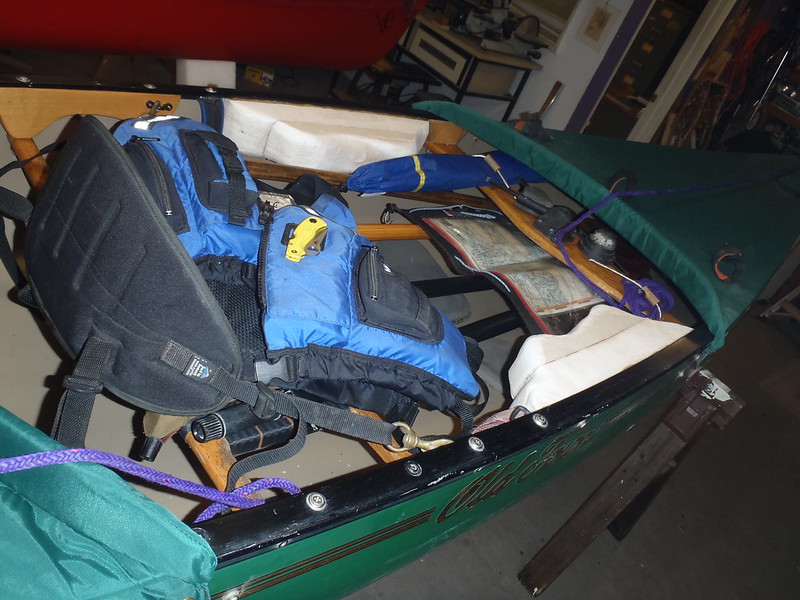 P2160540 by Mike McCrea, on Flickr
P2160540 by Mike McCrea, on Flickr
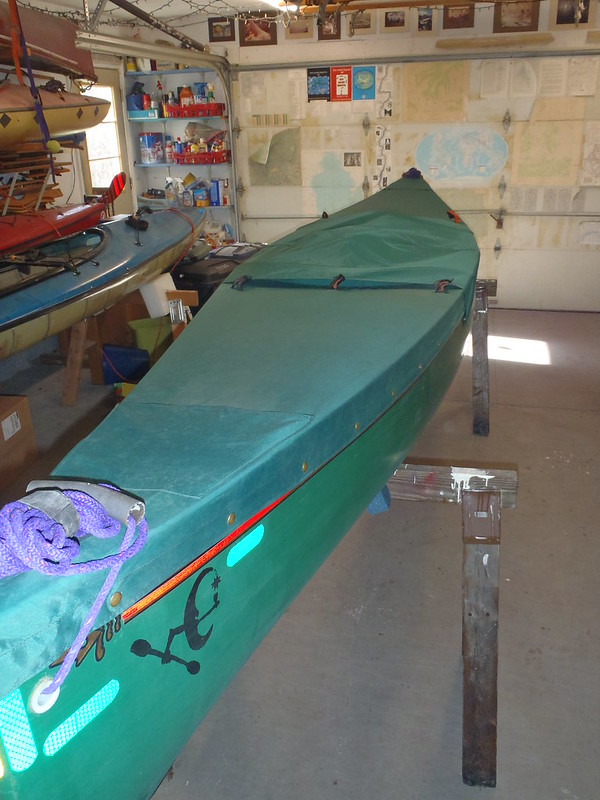 P2160542 by Mike McCrea, on Flickr
P2160542 by Mike McCrea, on Flickr
Time to make a work list.
All the brightwork needs to come out and be refinished. That will be revealing. There was some experimentation with sealing that wood using varnish vs spar urethane on the thwarts and drops, and some butt ends got urethane sealed, and some got epoxy coated.
Now that it is time to pull out and refinish the brightwork it would have been a grand experiment, except that the key to what I used where is in some long gone outfitting thread and I sure as hell do not remember.
The utility thwart needs some compass and bungee position rearrangement. Needs better map case attachment points. Foot brace bar needs split foam pipe insulation padding.
I made one big mistake in the original outfitting. The snap rivets for the spray covers need backing up inside the hull when originally installed. I could have used just a washer, but I wanted something there inside the hull for easy float bag lacing using those same though hull holes. Maybe something rectangular that would also accept a 1 inch strap.
The mistake was using something supposedly stainless steel. Stainless? That canoe has only seen saltwater a few times and always been rinsed. Stainless?
 P2170545 by Mike McCrea, on Flickr
P2170545 by Mike McCrea, on Flickr
26 freaking six of them spaced every 8 inches bow and stern. I am not drilling out and reinstalling 26 snap rivets in order to lose that rusty mess.
The nylon tabs are still in great shape, and they were well installed with a backing washer and epoxied on rubber caps for gear scrape protection, but the, harumpfff, stainless my arse, parts need to go. Those things shed rust at the slightest touch, which falls filthy into the bilge.
First order of reoutfitting business, take those rusty hunks of junk out and replace them with, um, I am thinking a run of 2.2mm Zing It line, threaded through the nylon tabs along each side, but I am open to better ideas or suggestions.
Second order of reoutfitting business, stay away from stainless steel of unknown quality.
The outfitting on the Penobscot was a multi year work in progress, and I have everything dang near exactly how I want it for comfort, convenience and safety. The jet boat driver on the Green called it The Inspector Gadget canoe, which I took as high praise, and they never even saw it with spray covers on.
The Cooke Custom Sewing partial spray covers suit my needs superbly, and the paddle pockets and straps are beyond useful for holding paddles, sail and pole accessible
Single blade, double blade, and sail on bow cover.
 P2160520 by Mike McCrea, on Flickr
P2160520 by Mike McCrea, on Flickr6 foot push pole, hiking staff, spare tarp pole on stern cover.
 P2160519 by Mike McCrea, on Flickr
P2160519 by Mike McCrea, on FlickrWith the spray covers attached there is no carry thwart available to grab at the stems, so grab handles on the painter loops are handy for when I really need to haul on something more hand kindly than rope.
 P2160522 by Mike McCrea, on Flickr
P2160522 by Mike McCrea, on FlickrThe painter lines do not usually go in that Velcro loop on the fabric. With the covers on there is not a lot of exposed gunwale to grab for control when exiting the canoe in wind or wave, and having the painters secured 8 feet away does not help.
Open cleat on the utility thwart for the bow line, along with the sail mount and compass. Dang, I really need to disassemble the utility thwart and drops and refinish them.
 P2160525 by Mike McCrea, on Flickr
P2160525 by Mike McCrea, on FlickrOpen cleat on truss seat drop for stern painter, in case I need to grab the stern line as well.
 P2160526 by Mike McCrea, on Flickr
P2160526 by Mike McCrea, on FlickrSail away.
 P2160528 by Mike McCrea, on Flickr
P2160528 by Mike McCrea, on FlickrBarcalounger comfortable with a slightly canted contour seat, inflation adjustable pad and back band. Another reason beefy truss drops are handy.
 P2160535 by Mike McCrea, on Flickr
P2160535 by Mike McCrea, on FlickrFoot brace and heel pads.
 P2160530 by Mike McCrea, on Flickr
P2160530 by Mike McCrea, on FlickrFour strategically placed D rings along the keel line. Webbing loop tie down points on the machine screw ends. Minicel wedge that holds the 30 or 60 liter barrel trapped between thwarts and away from the adjustable foot brace. That little minicel wedge is terrific to seat a barrel and hold it solidly from any movement.
 P2170546 by Mike McCrea, on Flickr
P2170546 by Mike McCrea, on FlickrStrap yoke with stainless double D rings
 P2160534 by Mike McCrea, on Flickr
P2160534 by Mike McCrea, on FlickrMassive knee bumpers. Those took multiple trips to get custom carved just right, but I can trim shift my bulk fore or aft a bit on the seat and still comfortably brace my knees, or thigh brace off the bottoms when I really want to lock in.
 P2160532 by Mike McCrea, on Flickr
P2160532 by Mike McCrea, on FlickrAnd, finally, the in camp piece de resistance, a center storage cover, so I can leave all of the paddling gear inside the canoe safe and dry and ready to go the next morning.
 P2160540 by Mike McCrea, on Flickr
P2160540 by Mike McCrea, on Flickr P2160542 by Mike McCrea, on Flickr
P2160542 by Mike McCrea, on FlickrTime to make a work list.
All the brightwork needs to come out and be refinished. That will be revealing. There was some experimentation with sealing that wood using varnish vs spar urethane on the thwarts and drops, and some butt ends got urethane sealed, and some got epoxy coated.
Now that it is time to pull out and refinish the brightwork it would have been a grand experiment, except that the key to what I used where is in some long gone outfitting thread and I sure as hell do not remember.
The utility thwart needs some compass and bungee position rearrangement. Needs better map case attachment points. Foot brace bar needs split foam pipe insulation padding.
I made one big mistake in the original outfitting. The snap rivets for the spray covers need backing up inside the hull when originally installed. I could have used just a washer, but I wanted something there inside the hull for easy float bag lacing using those same though hull holes. Maybe something rectangular that would also accept a 1 inch strap.
The mistake was using something supposedly stainless steel. Stainless? That canoe has only seen saltwater a few times and always been rinsed. Stainless?
 P2170545 by Mike McCrea, on Flickr
P2170545 by Mike McCrea, on Flickr26 freaking six of them spaced every 8 inches bow and stern. I am not drilling out and reinstalling 26 snap rivets in order to lose that rusty mess.
The nylon tabs are still in great shape, and they were well installed with a backing washer and epoxied on rubber caps for gear scrape protection, but the, harumpfff, stainless my arse, parts need to go. Those things shed rust at the slightest touch, which falls filthy into the bilge.
First order of reoutfitting business, take those rusty hunks of junk out and replace them with, um, I am thinking a run of 2.2mm Zing It line, threaded through the nylon tabs along each side, but I am open to better ideas or suggestions.
Second order of reoutfitting business, stay away from stainless steel of unknown quality.
